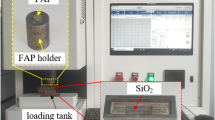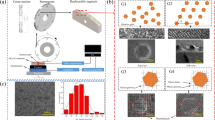Abstract
To achieve high efficiency in the polishing process to obtain a high surface quality of black LT substrate (a kind of soft brittle material), shear thickening polishing (STP),which is a “gentle” finishing process developed in recent years, was employed in this study. The influence of three key parameters in the STP process including polishing speed, diamond abrasive size and diamond abrasive concentration were analyzed. To investigate the potential mechanical effect of the nanometre abrasive, nano-SiO2 abrasive particles were added in the slurry, and the concentration of SiO2 abrasive was also taken as a factor. Taguchi method was utilized to evaluate the influence of the four factors and optimize the polishing conditions. The surface roughness (Ra/Rz) was used as the evaluation index, and the optimized polishing conditions were verified through experiments. Diamond abrasive size has the most significant effect on Ra/Rz, followed by diamond abrasive concentration and then SiO2 concentration, as the polishing speed has been selected and limited in a small variation rang according to the previous study. Based on the S/N average response analysis, the surface quality is the best under the conditions with 8000# diamond abrasive, 5 wt% diamond abrasive concentration, 90 rpm polishing speed and 10 wt% SiO2 concentration. After 4 min polishing, the surface roughness Ra/Rz is reduced rapidly from 200.5/1374.6 to 4.2/22.1 nm without embedded abrasive particles on the surface of the black LT substrate. It also shows that the mechanical effect plays a dominant role in the material removal. A certain amount (10 wt% in this study) of nano-SiO2 can reduce friction between solid colloidal and workpiece, and helps to improve surface quality.

















Similar content being viewed by others
References
Hang, W., Zhou, L., Zhang, K., Jun, S., & Yuan, J. (2016). Study on grinding of LiTaO3 wafer using effective cooling and electrolyte solution. Precision Engineering, 44, 62–69. https://doi.org/10.1016/j.precisioneng.2015.10.001.
Iyi, N., Kitamura, K., Izumi, F., Yamamoto, J. K., Hayashi, T., Asano, H., et al. (1992). Comparative-study of defect structures in lithium-niobate with different compositions. Journal of Solid State Chemistry, 101(2), 340–352. https://doi.org/10.1016/0022-4596(92)90189-3.
Zhu, N., Zheng, F., Zhu, Y., Xu, S., & Zuo, D. (2016). Research of abrasive embedment-free lapping on soft-brittle lithium niobate wafer. The International Journal of Advanced Manufacturing Technology, 87(5–8), 1951–1956. https://doi.org/10.1007/s00170-016-8582-8.
Wei, X., Yuan, H., Du, H. W., Xiong, W., & Huang, R. W. (2006). Study on chemical mechanical polishing mechanism of LiTaO3 wafer. In G. Cai, X. P. Xu, & R. Kang (Eds.), Key engineering materials (Vol. 304–305, pp. 310–314). (Reprinted). https://doi.org/10.4028/www.scientific.net/KEM.304-305.310.
Hyun, S. L. (2015). Effect of citric acid in chemical mechanical polishing (CMP) for lithium tantalate (LiTaO3) wafer. Advanced Materials Research, 1136, 305–310. https://doi.org/10.4028/www.scientific.net/AMR.806.305.
Park, C., Kim, H., Lee, S., & Jeong, H. (2015). The influence of abrasive size on high-pressure chemical mechanical polishing of sapphire wafer. International Journal of Precision Engineering and Manufacturing-Green Technology, 2(2), 157–162. https://doi.org/10.1007/s40684-015-0020-0.
Park, C., Kim, H., Cho, H., Lee, T., Kim, D., Lee, S., et al. (2019). Effect of relative surface charge of colloidal silica and sapphire on removal rate in chemical mechanical polishing. International Journal of Precision Engineering and Manufacturing-Green Technology, 6(2), 339–347. https://doi.org/10.1007/s40684-019-00020-9.
Jang, K., Seok, J., & Min, B. (2009). A 3D model for magnetorheological fluid that considers neighboring particle interactions in 2D skewed magnetic fields. International Journal of Precision Engineering and Manufacturing, 10, 115–118. https://doi.org/10.1007/s12541-009-0017-0.
Ahmed, G. M. S., Reddy, P. R., & Seetharamaiah, N. (2012). Experimental investigation of magneto rheological damping effect on surface roughness of work piece during end milling process. International Journal of Precision Engineering and Manufacturing, 13, 835–844. https://doi.org/10.1007/s12541-012-0109-0.
Kim, W., Nam, E., & Min, B. (2015). Material removal of glass by magnetorheological fluid jet. International Journal of Precision Engineering and Manufacturing, 16, 629–637. https://doi.org/10.1007/s12541-015-0084-3.
Natarajan, Y., Murugasen, P. K., Sundarajan, L. R., & Arunachalam, R. (2019). Experimental investigation on cryogenic assisted abrasive water jet machining of aluminium alloy. International Journal of Precision Engineering and Manufacturing-Green Technology, 6(3), 415–432. https://doi.org/10.1007/s40684-019-00072-x.
Jang, Y. H., Ahn, D. G., Kim, J., & Kim, W. S. (2018). Re-melting characteristics of a stellite21 deposited part by direct energy deposition process using a pulsed plasma electron beam with a large irradiation area. International Journal of Precision Engineering and Manufacturing-Green Technology, 5(4), 467–477. https://doi.org/10.1007/s40684-018-0050-5.
Abrego Serrano, P. A., Kim, M., & Kim, D. (2020). Spherical mirror and surface patterning on silicon carbide (SiC) by material removal rate enhancement using CO2 laser assisted polishing. International Journal of Precision Engineering and Manufacturing. https://doi.org/10.1007/s12541-019-00304-9.
Qiu, Z., Zhou, L., Fang, F., Tsuyoshi, S. A., & Hiroshi, E. (2010). Chemical mechanical grinding for quartz glass. Optics and Precision Engineering, 18(7), 1554–1561. https://doi.org/10.3788/OPE.20101807.1554.
Moriyama, K., Ozeki, A., Haba, S., & Mori, M. (2016, December). The effect of slurry pH and particle size on LiTaO 3 polishing. In 2016 International Symposium on Semiconductor Manufacturing (ISSM) (pp. 1–3). IEEE
Gruber, M., Leitner, A., Kiener, D., Supancic, P., & Bermejo, R. (2018). Incipient plasticity and surface damage in LiTaO3 and LiNbO3 single crystals. Material and Design, 153, 221–231. https://doi.org/10.1016/j.matdes.2018.04.082.
Li, M., Lyu, B., Yuan, J., Dong, C., & Dai, W. (2015). Shear-thickening polishing method. International Journal of Machine Tools and Manufacture, 94, 88–99. https://doi.org/10.1016/j.ijmachtools.2015.04.010.
Cheng, X., McCoy, J. H., Israelachvili, J. N., & Cohen, I. (2011). Imaging the microscopic structure of shear thinning and thickening colloidal suspensions. Science, 333(6047), 1276–1279. https://doi.org/10.1126/science.1207032.
Bender, J., & Wagner, N. J. (1996). Reversible shear thickening in monodisperse and bidisperse colloidal dispersions. Journal of Rheology, 40(5), 899–916. https://doi.org/10.1122/1.550767.
Galindo-Rosales, F. J., Rubio-Hernández, F. J., Sevilla, A., & Ewoldt, R. H. (2011). How Dr. Malcom M. Cross may have tackled the development of “An apparent viscosity function for shear thickening fluids. Journal of Non-Newtonian Fluid Mechanics, 166(23–24), 1421–1424. https://doi.org/10.1016/j.jnnfm.2011.08.008.
Wagner, N. J., & Brady, J. F. (2009). Shear thickening in colloidal dispersions. Physics Today, 62(10), 27–32. https://doi.org/10.1063/1.3248476.
Lee, Y. S., Wetzel, E. D., & Wagner, N. J. (2003). The ballistic impact characteristics of Kevlar (R) woven fabrics impregnated with a colloidal shear thickening fluid. Journal Materials Science, 38(13), 2825–2833. https://doi.org/10.1023/A:1024424200221.
Crawford, N. C., Yohe, B., Williams, S. K. R., Boldridge, D., & Liberatore, M. W. (2013). Shear thickening and shear-induced agglomeration of chemical mechanical polishing slurries using electrolytes. Rheologica Acta, 52(52), 499–513. https://doi.org/10.1007/s00397-013-0711-9.
Li, M., Lyu, B., Yuan, J., Yao, W., Zhou, F., & Zhong, M. (2016). Evolution and equivalent control law of surface roughness in shear-thickening polishing. International Journal of Machine Tools and Manufacture, 108, 113–126. https://doi.org/10.1016/j.ijmachtools.2016.06.007.
Li, M., Yuan, J., Lu, B., Yao, W., & Dai, W. (2015). Experimental investigation into Si3N4 ceramics machined via shear-thickening polishing method. Journal of South China University of Technology (Natural Science Edition), 43(9), 113–120. https://doi.org/10.3969/j.issn.1000-565X.2015.09.018.
Weng, H., Lu, B., Hu, G., Shao, Q., & Dai, W. (2017). Optimization experiments for shear thickening polishing of quartz substrates. Nanotechnology and Precision Engineering, 15(3), 227–233. https://doi.org/10.13494/j.npe.20160087.
Nalbant, M., Gokkaya, H., & Sur, G. (2007). Application of Taguchi method in the optimization of cutting parameters for surface roughness in turning. Materials and Design, 28(4), 1379–1385. https://doi.org/10.1016/j.matdes.2006.01.008.
de Castro, C. C., Plaine, A. H., de Alcantara, N. G., & Dos Santos, J. F. (2018). Taguchi approach for the optimization of refill friction stir spot welding parameters for AA2198-T8 aluminum alloy. The International Journal of Advanced Manufacturing Technology, 99(5–8), 1927–1936. https://doi.org/10.1007/s00170-018-2609-2.
Shaji, S., & Radhakrishnan, V. (2003). Analysis of process parameters in surface grinding with graphite as lubricant based on the Taguchi method. Journal of Materials Processing Technology, 141(1), 51–59. https://doi.org/10.1016/S0924-0136(02)01112-3.
Dhavlikar, M. N., Kulkarni, M. S., & Mariappan, V. (2003). Combined Taguchi and dual response method for optimization of a centerless grinding operation. Journal of Materials Processing Technology, 132(1–3), 90–94. https://doi.org/10.1016/s0924-0136(02)00271-6.
Meseguer-Valdenebro, J. L., Portoles, A., & Matinez-Conesa, E. (2018). Electrical parameters optimisation on welding geometry in the 6063-T alloy using the Taguchi methods. The International Journal of Advanced Manufacturing Technology, 98(9–12), 2449–2460. https://doi.org/10.1007/s00170-018-2395-x.
Huu-Phan, N., Van-Dong, P., & Ngoc-Vu, N. (2018). Application of TOPSIS to Taguchi method for multi-characteristic optimization of electrical discharge machining with titanium powder mixed into dielectric fluid. The International Journal of Advanced Manufacturing Technology, 98(5–8), 1179–1198. https://doi.org/10.1007/s00170-018-2321-2.
Li, M., Yuan, J., & Lu, B. (2015). Preparation of shear thickening polishing abrasive slurries and their polishing properties. Optics and Precision Engineering, 23(9), 2513–2521. https://doi.org/10.3788/OPE.20152309.2513.
Evans, C. J., Paul, E., Dornfeld, D., Lucca, D. A., & Mullany, B. A. (2003). Material removal mechanisms in lapping and polishing. CIRP Annals-Manufacturing Technology, 52(2), 611–663.
Kato, T., Kasuga, H., Ohmori, H., & Itoh, N. (2013). Electrolytic in-process dressing grinding of sapphire with nanodiamond composite wheel. International Journal of Nanomanufacturing, 9(5–6), 510–519.
Acknowledgements
The authors gratefully acknowledge the financial support from Zhejiang Natural Science Foundation (No. LR17E050002), National Natural Science Foundation of China (51605440) and China Postdoctoral Science Foundation funded project (2017M621966).
Author information
Authors and Affiliations
Corresponding author
Additional information
Publisher's Note
Springer Nature remains neutral with regard to jurisdictional claims in published maps and institutional affiliations.
Rights and permissions
About this article
Cite this article
Lyu, B.H., Shao, Q., Hang, W. et al. Shear Thickening Polishing of Black Lithium Tantalite Substrate. Int. J. Precis. Eng. Manuf. 21, 1663–1675 (2020). https://doi.org/10.1007/s12541-020-00362-4
Received:
Revised:
Accepted:
Published:
Issue Date:
DOI: https://doi.org/10.1007/s12541-020-00362-4




